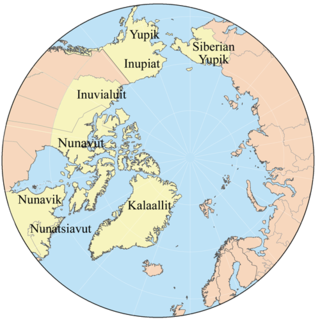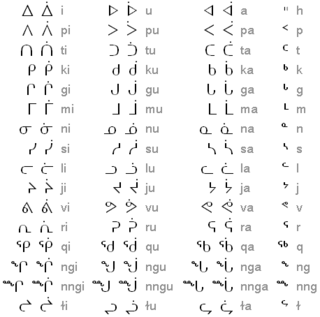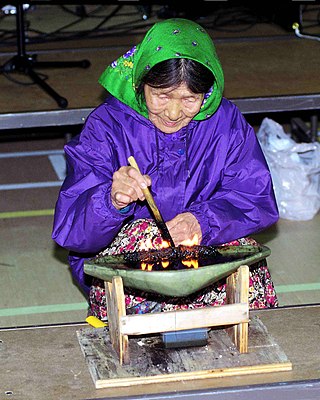Minik is a Greenlandic Inuit name meaning "viscid train oil which is being used as sealing for skin boats". [1] The name was given to Prince Vincent of Denmark, born in 2011, as one of his middle names.

Eskimo is an exonym used to refer to two closely related Indigenous peoples: Inuit and the Yupik of eastern Siberia and Alaska. A related third group, the Aleut, which inhabit the Aleutian Islands, are generally excluded from the definition of Eskimo. The three groups share a relatively recent common ancestor, and speak related languages belonging to the Eskaleut language family.

Robert Edwin Peary Sr. was an American explorer and officer in the United States Navy who made several expeditions to the Arctic in the late 19th and early 20th centuries. He is best known for, in April 1909, leading an expedition that claimed to be the first to have reached the geographic North Pole.
In Inuit religion, Nanook was the master of bears, meaning he decided if hunters deserved success in finding and hunting bears and punished violations of taboos. The word was popularized by Nanook of the North, the first feature-length documentary.

Inuktitut syllabics is an abugida-type writing system used in Canada by the Inuktitut-speaking Inuit of the territory of Nunavut and the Nunavik and Nunatsiavut regions of Quebec and Labrador, respectively. In 1976, the Language Commission of the Inuit Cultural Institute made it the co-official script for the Inuit languages, along with the Latin script.
Kenn Harper is a Canadian writer, historian and former businessman. He is the author of Give Me My Father's Body, an account of Greenland Inuk Minik Wallace, had a regular column on Arctic history in Nunatsiaq News and is a former landlord.

Minik Wallace was an Inughuaq (Inuk) brought as a child in 1897 from Greenland to New York City with his father and others by the explorer Robert Peary. The six Inuit were studied by staff of the American Museum of Natural History, which had custody. The adults and one child died soon of tuberculosis (TB), and one young man was returned to Greenland. After deceiving Minik with a staged burial, the museum put the skeleton of his father on exhibit. Minik was adopted by William Wallace, the museum's building superintendent, and did not return to Greenland until after 1910. He returned to the United States a few years later, where he remained and worked until dying of influenza in the 1918 pandemic.

North Stratford is an unincorporated community in the town of Stratford in Coos County, New Hampshire, United States. It is located in the northwest corner of the town, along the Connecticut River and adjacent to Bloomfield, Vermont.
The Ottawa Islands are a group of currently uninhabited islands situated in the eastern edge of Canada's Hudson Bay. The group comprises 24 small islands, located at approximately 60N 80W. The main islands include Booth Island, Bronson Island, Eddy Island, Gilmour Island, J. Gordon Island, Pattee Island, and Perley Island. The highest point is on Gilmour Island, which rises to over 1,800 ft (550 m). Located a short distance off the northwest coast of Quebec's Ungava Peninsula, they, like the other coastal islands in Hudson Bay, were historically part of the Northwest Territories, and became Crown Land upon the creation of Nunavut in 1999. Nunavik Inuit have occupied these islands since time immemorial and gained constitutionally-protected harvest and access rights under the Nunavik Inuit Land Claim Agreement signed in 2007.
Minnick is an Irish surname that could be an Anglicization of the Gaelic Ó Muineóg, or could be derived from manach meaning "monk".
Minnich is a surname. Notable people with the surname include:
Minich is a surname. Notable people with the surname include:
Minik may refer to:

The Inuit are an indigenous people of the Arctic and subarctic regions of North America. The ancestors of the present-day Inuit are culturally related to Iñupiat, and Yupik, and the Aleut who live in the Aleutian Islands of Siberia and Alaska. The term culture of the Inuit, therefore, refers primarily to these areas; however, parallels to other Eskimo groups can also be drawn.

Prince Vincent of Denmark, Count of Monpezat is a member of the Danish royal family. He is the third child and younger son of Crown Prince Frederik and Crown Princess Mary, the sixth grandchild and youngest grandson of Queen Margrethe II and Prince Henrik, and the older twin brother of Princess Josephine.

Greenlandic Americans are Americans of Greenlandic descent.
Qumaq (ᖁᒪᖅ) is an Inuit given name and surname. While initially just a given name, it was recorded as a family name by the Canadian government, meaning that this last name is now inheritable from parent to child. Qumaq means intestinal worms or worms from lakes.
Nivi is a Greenlandic Inuit feminine given name meaning “girl.” It has been a popular name for girls in Greenland in recent years. Another popular variant of the name is Niviaq.
Inuk is a Greenlandic Inuit given name meaning “human being.” It is used for both males and females but has been a popular name for boys in Greenland in recent years.